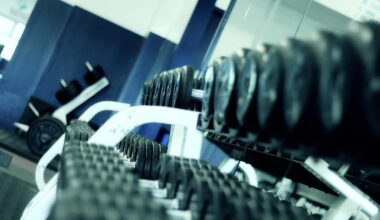Advanced Resistance Training Techniques for Elite Football Athletes
Resistance training is crucial for elite football athletes to improve strength, speed, and overall performance. Incorporating advanced techniques can significantly enhance an athlete’s physical capacity. These techniques should focus on specific muscle groups used in football, such as the legs, core, and upper body. Specific methods include plyometric exercises that can develop explosive power. Exercises like box jumps and depth jumps can effectively enhance an athlete’s vertical jump and sprint speed. Additionally, integrating Olympic lifts, such as clean and jerk or snatch, promotes strength, power, and coordination. Maintaining balance in training is vital, so athletes should incorporate both upper and lower body exercises to ensure overall body strength. Furthermore, progressive overload is essential; athletes should systematically increase weight, repetitions, or intensity to continually challenge their muscles. Workouts should be periodized, alternating between strength, hypertrophy, and power phases. Furthermore, recovery through proper nutrition and rest is critical for optimizing performance. Monitoring the athlete’s overall health and ensuring proper technique is necessary to prevent injuries and improve effectiveness.
Importance of Plyometric Exercises
Plyometric exercises are key components of resistance training in football. They focus on explosive movements that help improve strength and rapid force production. This is essential for sprinting, jumping, and directional changes during matches. Incorporating these exercises into a training routine can increase muscle fiber recruitment, leading to better athletic performance. High-Intensity Interval Training (HIIT) combined with plyometrics can elevate heart rate, burn fat, and improve cardiovascular fitness. Typical plyometric exercises include bounding, squat jumps, and lateral jumps. For optimal results, these should be executed with precision, ensuring maximal exertion. Including agility drills enhances coordination and balance, further contributing to performance. Athletes should monitor their increases in power output and agility over time to quantify improvements. Proper unlock with stretching and cooldown is critical to prevent injuries that may arise from high-impact activities. Coaches can tailor plyometric routines based on individual athlete needs to maximize effectiveness. These workouts yield substantial performance benefits when executed in a well-structured training plan. In conjunction with other resistance training techniques, plyometrics can be transformative for football players aiming for peak performance.
Functional training is another essential aspect of advanced resistance training for football athletes. It focuses on movements that simulate actual game scenarios, improving an athlete’s ability to perform on the pitch. Exercises like kettlebell swings, medicine ball throws, and single-leg deadlifts are beneficial. These actions engage multiple muscle groups, enhancing strength and stability. The core plays an integral role in virtually every movement during a football match; hence, integrating core-centric exercises like planks and rotational movements is vital. Maintaining body balance while under dynamic conditions is crucial; it enhances coordination and body control during gameplay. Functional training not only increases overall strength but also minimizes the risk of injuries by building stronger stabilizing muscles. Athletes can often visualize their performance improvements by practicing these functional movements regularly. Specific drills, such as lateral lunges and sled pushes, can develop the fast-twitch muscle fibers crucial for quick movements. Continuous assessment of functional performance can guide adjustments to the training regimen. The incorporation of varied equipment, like resistance bands and stability balls, further diversifies functional training regimens.
Emphasizing Recovery and Nutrition
Recovery is as crucial as the workouts themselves for football athletes undergoing intensive training. Enhanced recovery helps to rebuild muscles, preventing fatigue and injury. Strategies include sufficient sleep, hydrotherapy, and foam rolling to alleviate muscle soreness. Two crucial elements for recovery are nutrition and hydration. Athletes must prioritize post-training meals with protein and carbohydrates to stimulate muscle recovery and replenish glycogen stores. Incorporating nutrient-dense foods such as lean meats, whole grains, fruits, and vegetables can optimize muscle repair. Supplements like creatine and branched-chain amino acids (BCAAs) may support muscle maintenance, although they should always be consulted with a nutritionist. Drinking adequate fluids is imperative to remain hydrated throughout rigorous training sessions. Additionally, athletes should educate themselves about mindful eating and portion control to ensure proper nutrition. With plenty of vitamins and minerals, including omega-3 fatty acids, athletes can enhance their immune system resilience. Balancing workout sessions with adequate restoration can dramatically increase performance levels. A tailored nutrition program will enhance an athlete’s resilience and potential for rapid recovery after intensive workouts.
Monitoring progress through performance metrics is essential for football athletes utilizing advanced resistance training techniques. Establishing solid baselines allows athletes and coaches to gauge improvements and adapt their training plans accordingly. Common metrics include max strength lifts, agility measures, and speed tests, which help quantify physical gains. Technology advancements, such as wearable devices, can facilitate this by measuring metrics like heart rate variability and muscle exertion levels. Tracking individual performance variables ensures a personalized approach during training regimens. Regular evaluations promote accountability, encouraging motivation in athletes. Furthermore, qualitative assessments, like video analysis of movements, can identify improper execution techniques, allowing for timely adjustments. Communication between athletes and coaches regarding performance trends helps to effectively address weaknesses and strengths. This collaborative approach enhances motivation, making training sessions more productive. Employing systematic data collection allows for informed decision-making, optimizing the training workloads based on an athlete’s physical state. Adaptability is crucial; as athletes progress, they may need different recovery or resistance training methods as they advance through their training cycle.
Conclusion: Building Holistic Training Programs
In conclusion, creating holistic resistance training programs for elite football athletes requires a comprehensive understanding of advanced techniques. These programs should combine strength, function, and recovery elements to promote overall athletic performance and minimize injury risk. Approaching resistance training with diversity—incorporating plyometric, functional, and strength movements—ensures that athletes develop well-rounded physical capabilities. Moreover, prioritizing recovery and nutrition alongside intense training regimens is imperative. By focusing on sport-specific needs, coaches can create tailored performance plans for each athlete. Adapting training intensity, volume, and recovery strategies based on individual requirements enables optimization of training outcomes. As athletes progress, they can achieve increased performance levels through sustained dedication and systematic training evaluations. Ongoing development within their resistance training plans will enhance their competitive edge in football. Future research and continuous learning in the field of sports science can further encourage effective methods in resistance training. By embracing these core principles, football athletes can maximize their athletic prowess through intelligent resistance training, making significant gains in their fitness and performance. Coaches and athletes must unite their efforts to ensure a common goal: optimal performance on the football pitch.
As we have explored throughout this article, resistance training is an indispensable part of enhancing a football athlete’s performance. The integration of advanced techniques promises not only improvements in strength but also in speed, power, and agility. These elements significantly contribute to an athlete’s success on the pitch. Developing strength and power through resistance exercises aids in greater performance capabilities in various football aspects, such as tackling, sprinting, and jumping. Specific methodologies, including plyometrics and functional movements, enhance the athlete’s competitive edge through improved physical conditioning. Recovery measures, along with nutritional strategies, form a critical component that supports the athlete’s overall health. When athletes are equipped with proper nutritional knowledge, they can optimize their performance and recovery processes. Monitoring and adapting training based on individual progress creates a more personalized approach, fostering accountability. Engaging in a range of exercises stimulates muscle growth while minimizing fatigue. A holistic methodology that intertwines training, nutrition, and recovery paves the way for continued success. Ultimately, football fitness through advanced resistance training sets the stage for unparalleled performance on the field.
By investing time and effort into advanced resistance training techniques, elite football athletes can achieve significant enhancements in their physical capabilities. Understanding the role of resistance training in an athlete’s regimen is critical for development and success. As discussed, emphasizing varied movements and focusing on recovery and nutrition contributes to overall performance improvement. Establishing robust training protocols fosters an environment ripe for growth, while monitoring progress ensures that athletes remain on track. Aside from physically enhancing their skills, these training techniques instill discipline, dedication, and resilience in athletes. These attributes are invaluable not just in sports but across life’s challenges. An athlete’s commitment to their training regimen plays a decisive role in shaping their identity as a competitive player in the football arena. By continually innovating their methods, athletes can push the boundaries of their physical potential. They stand on the verge of transforming their performance capabilities on the football field. Integrating advanced resistance training into their routine provides a solid pathway to achieving peak athletic performance. The culmination of these methods positions athletes to expand their reach and effectiveness within the game of football.


